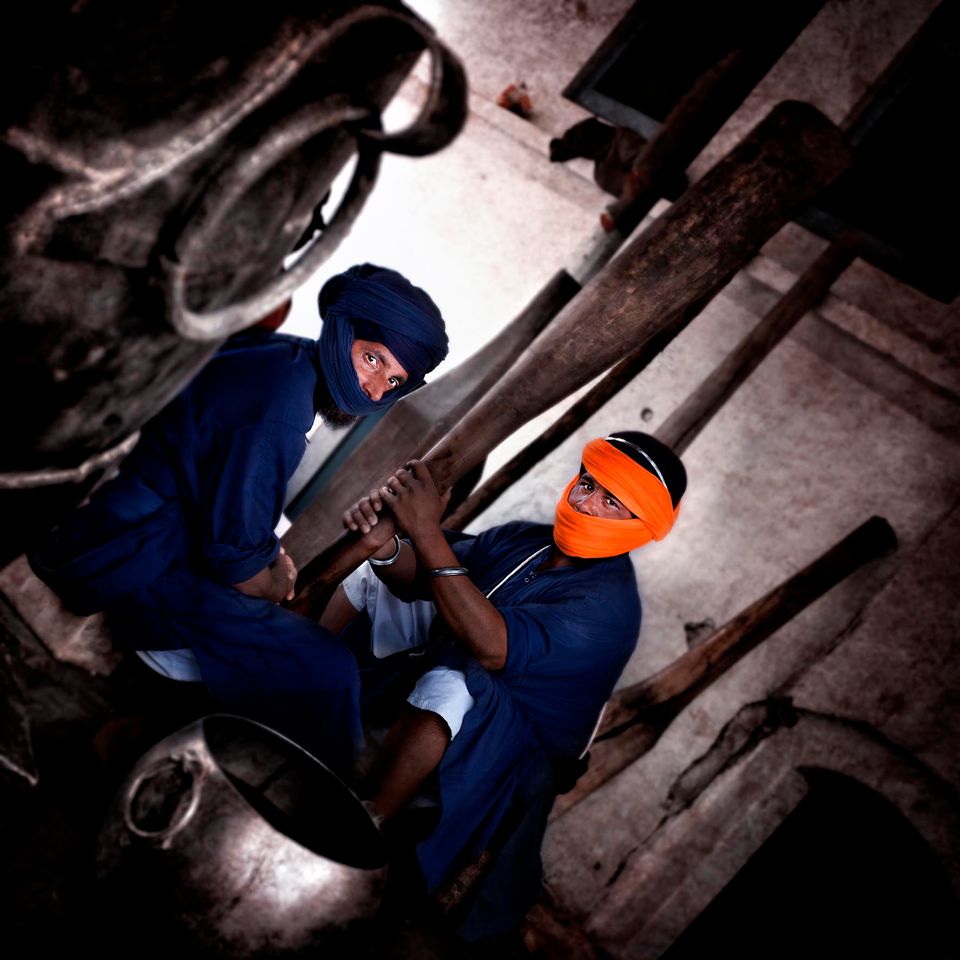Jhatka & Shaheedi Degh

Sant Giani Kartar Singh (Mota Akhar) have written that for maintaining Dharam, destroying enemies, preserving their own lives in times of war, and living in the jungles, Nihung Singhs used to hunt and eat chhatri-bhojan for survival and this puratan maryada is maintained today with the practice of jhatka. This is not for the taste of the tongue. If someone eats for their taste of tongue then they will take on the karam attached to it because it says in the rehatnamey:
ਸੁਆਦਲਾ ਲੰਗਰ ਵੇਖਕੇ ਲਾਲਚ ਕਰੇ ਅਤੇ ਬੇਸੁਆਦਲਾ ਵੇਖਕੇ ਨਿੰਦਾ ਕਰੇ ਤਨਖਾਹੀਆ।
Puratan Nihung Singhs used to do jhatka in difficult times and never ate religiously prepared meat. If someone asked Puratan Singhs about jhatka then they used to quote Kalgidhar Maharaj’s Bachan:
ਹੁੱਕਾ ਹਜ਼ਾਮਤ ਹਲਾਲੋ ਹਰਾਮ॥
ਬਾ ਰੀਸ਼ੇ ਹਿਨਾਂ ਕਰਦ ਰੂ ਸਿਆਹ ਫਾਮ॥
and used to read bachans from Rehatnamey:
ਕਰ ਝਟਕੈ ਬੱਕਰਨ ਕੋ ਖੱਯੋ ॥
ਮੁਰਦੈ ਕੁੱਠੈ ਨਿਕਟ ਨ ਜੱਯੋ॥
(ਰਤਨ ਸਿੰਘ ਭੰਗੂ)
ਬਕਰਾ ਝਟਕਾ ਛਕੇ ਤਾਂ ਛਕੈ॥
ਔਰ ਮਾਸ ਵਲ ਕਬੀ ਨ ਤਕੈ ॥੩੨॥
(ਰਹਿਤਨਾਮਾ ਦੇਸਾ ਸਿੰਘ)
ਕੁਸਿਆ ਮਾਸ ਨ ਖਾਈਐ, ਪਾਲਿਆ ਖਾਇ ਨ ਸੂਰ॥
(ਮੁਕਤਨਾਮਾ ਭਾਈ ਸਾਹਿਬ ਸਿੰਘ)
In this way, jhatka is done and Chhatri-Bhojan’s maryada has a puratan history with Nihung Singhs. From Puratan times, some Nihung Singhs eat jhatka and some Nihung Singhs stay vegetarian.
For the treatment of bodily diseases and battle wounds, desi medicinal roots, Shaheedi Degh (Sukha), Afeem etc was also utilized. This use is mentioned in Rehatnamay as well:
ਰਤੀ ਅਫੀਮ ਮਾਸਾ ਭੰਗ।
ਇਨ ਕੋ ਖਾਵਹਿ ਕਦੀ ਨਿਸੰਗ॥੩੧॥
ਇਸ ਤੇ ਅਧਿਕ ਨ ਅਮਲ ਵਧਾਵੈ॥
ਵਧੈ ਅਮਲ ਤੋ ਨਰ ਦੁਖ ਪਾਵੈ॥
(ਰਹਿਤਨਾਮਾ ਦੇਸਾ ਸਿੰਘ)
In Olden times, Nihung Singhs utilized 5 things in their Shaheedi Degh: 1) Almonds/Nuts, 2) Poppy Seed, 3) Black Pepper, 4) Cardamom (Ilaichi) and 5) 5 leafs of Degh (Sukha). This was an ashaudi (medicine) prepared by Nihung Singhs.
In Puratan times, Degh was referred to as the queen of medicinal herbs and within every medicine it was used among the like of afeem. Allopathy (Western medicine) was not used before. Everyone got treatment based on Ayurveda, Homeopathy, etc which included the use of afeem, bhang etc.
This herb along with afeem was used commonly. The heart-related, mind-related, digestive system-related, restlessness, and cancer etc were avoided. In 1870, the US army gave Degh the label of medicine.
Then when the British Raj happened, all of the Puratan knowledge of treatment, politics, weaponry became lost and a new wave began. In that time of 1910-1920, the British government kept the population away from Degh, Afeem, in order to sell their own medicines. The farming of Afeem etc had become a licensed process and afeem became confiscated.
Look at how tobacco is damaging to the body but it was never banned. On the other hand, afeem had become banned. From this we can realize the interference of the British Government and how the lifestyle/cultural boat of South Asia sunk.
In order to alleviate pain in wounds, Puratan Singhs used to put the Degh da Nugda on top of wounds as the wounds would dry faster as well and also used to eat it to prevent bodily diseases. Today in England and Canada, cannabis oil is taken as medicine. The name of this oil is CBD and you can find out more about it on the internet. Degh and afeem have antibiotic qualities (compared to modern day medicine) which can destroy many types of infections. This is the reason why Puratan Nihung Singhs used to do serve this and read from their mouths:
ਜਿਹੜਾ ਕਰੇ ਸੁੱਖੇ ਦੀ ਬਦੀ। ਪਿਉ ਉਸਦਾ ਗਧਾ ਅਤੇ ਮਾਂ ਗਧੀ।
Whoever increases the amount of Sukha, his father is a male-donkey and his mother is a female-donkey.
Furthermore, in the rehatnaamey, the use of this is on a medicinal basis and a drop of afeem (specifically mentioned) and little bhang (degh) is utilized. No Singh should use it as amal (addiction/intoxicant). Kalgidhar Maharaj Ji have referred to an example of overuse of this herb in Charitropakhyaan where a Raja (King) named Bijiaa overused Degh. The King became quite sorrowful, lost his intelligence and reason in the process:
ਬਿਜੀਯਾ ਏਕ ਨਿਪਤਿ ਬਹੁ ਖਈ॥ ਤਾਂ ਤੇ ਬੁਧਿ ਤਾ ਕੀ ਸਭ ਗਈ॥
(ਦਸਮ ਅੰਗ ੧੧੭੩)
In Sau Sakhi it also mentions the overuse of this herb:
ਮਦਿਰਾ ਸਪਤ ਕੁਲ ਦਹਿਤਾ, ਭਾਂਗ ਦਹੈ ਤਨੁ ਏਕ ਜਗਤਝੂਠ ਸਪਤ ਕੁਲ ਦਹਿਤਾ, ਨਿੰਦਿਆ ਦਹੈ ਅਨੇਕ॥
The reason to bring this up is to understand how Aad Guru Granth Sahib Ji’s Bani stops us from using alcohol and intoxicants.
ਝੂਠਾ ਮਦੁ ਮੂਲਿ ਨ ਪੀਚਈ ਜੇ ਕਾ ਪਾਰਿ ਵਸਾਇ ॥
And for the sustenance of this human body, Guru Maharaj’s Gurbani gives teaching:
ਨਾਨਕ ਸੋ ਪ੍ਰਭ ਸਿਮਰੀਐ ਤਿਸੁ ਦੇਹੀ ਕਉ ਪਾਲਿ॥੨॥
That’s why to keep away from bodily illnesses, Puratan Nihung Singhs utilized degh as a medicine. Their bodies remained illness-free and helped them a lot in healing their wounds. Having a healthy body gave them the ability to Jap Vaheguru’s Name. Puratan Nihung Singhs used to live free and independently. They never accepted other people’s commands. In this way, Nihung Singhs would never let themselves get put under the control of an intoxicant.
--
Translator's Note: Giani Ji clearly states that jhatka started in times where other food was not available and degha/afeem were used for medicinal purposes. They mention how they were never used for taste or intoxication.
In rehatnamey, it specifically mentions the very small quantity utilized and that whoever uses it increasingly for intoxication will have to face hell. (ਵਧੈ ਅਮਲ ਤੋ ਨਰ ਦੁਖ ਪਾਵੈ) A lot of these substances are used in western medicine but in a controlled amount. Hopefully, this helps us to investigate our own medicinal tradition and the study of ayurveda. Please forgive for any mistakes.
~Aaeenaa

